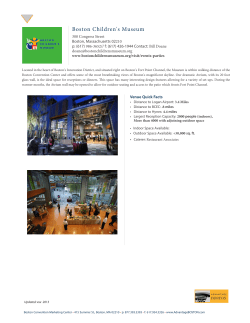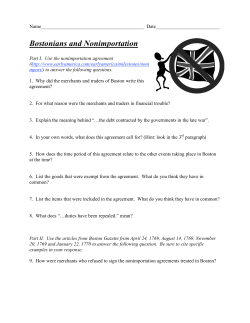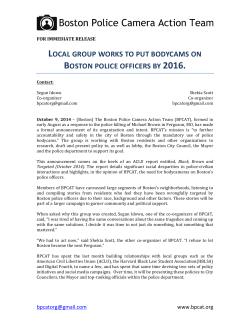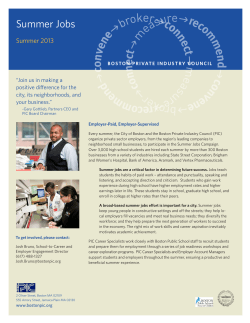
Product Life Cycles and the Boston Matrix Copyright 2006 – Biz/ed
http://www.bized.co.uk Product Life Cycles and the Boston Matrix Copyright 2006 – Biz/ed http://www.bized.co.uk Product Life Cycles and the Boston Matrix • Product Life Cycle – shows the stages that products go through from development to withdrawal from the market • Product Portfolio – the range of products a company has in development or available for consumers at any one time • Managing product portfolio is important for cash flow Copyright 2006 – Biz/ed http://www.bized.co.uk Product Life Cycles and the Boston Matrix • Product Life Cycle (PLC): – – – – Each product may have a different life cycle PLC determines revenue earned Contributes to strategic marketing planning May help the firm to identify when a product needs support, redesign, reinvigorating, withdrawal, etc. – May help in new product development planning – May help in forecasting and managing cash flow Copyright 2006 – Biz/ed http://www.bized.co.uk Product Life Cycles and the Boston Matrix • The Stages of the Product Life Cycle: – – – – – – – Development Introduction/Launch Growth Maturity Saturation Decline Withdrawal Copyright 2006 – Biz/ed http://www.bized.co.uk Product Life Cycles and the Boston Matrix • The Development Stage: • Initial Ideas – possibly large number • May come from any of the following – – – – – – – Market research – identifies gaps in the market Monitoring competitors Planned research and development (R&D) Luck or intuition – stumble across ideas? Creative thinking – inventions, hunches? Futures thinking – what will people be using/wanting/needing 5,10,20 years hence? Copyright 2006 – Biz/ed http://www.bized.co.uk Product Life Cycles and the Boston Matrix • Product Development: Stages – New ideas/possible inventions – Market analysis – is it wanted? Can it be produced at a profit? Who is it likely to be aimed at? – Product Development and refinement – Test Marketing – possibly local/regional – Analysis of test marketing results and amendment of product/production process – Preparations for launch – publicity, marketing campaign Copyright 2006 – Biz/ed http://www.bized.co.uk Product Life Cycles and the Boston Matrix • Introduction/Launch: – Advertising and promotion campaigns – Target campaign at specific audience? – Monitor initial sales – Maximise publicity – High cost/low sales – Length of time – type of product Copyright 2006 – Biz/ed http://www.bized.co.uk Product Life Cycles and the Boston Matrix • Growth: – Increased consumer awareness – Sales rise – Revenues increase – Costs - fixed costs/variable costs, profits may be made – Monitor market – competitors reaction? Copyright 2006 – Biz/ed http://www.bized.co.uk Product Life Cycles and the Boston Matrix • Maturity: – – – – – – – – Sales reach peak Cost of supporting the product declines Ratio of revenue to cost high Sales growth likely to be low Market share may be high Competition likely to be greater Price elasticity of demand? Monitor market – changes/amendments/new strategies? Copyright 2006 – Biz/ed http://www.bized.co.uk Product Life Cycles and the Boston Matrix • Saturation: • New entrants likely to mean market is ‘flooded’ • Necessity to develop new strategies becomes more pressing: – Searching out new markets: – – – – – • Linking to changing fashions • Seeking new or exploiting market segments • Linking to joint ventures – media/music, etc. Developing new uses Focus on adapting the product Re-packaging or format Improving the standard or quality Developing the product range Copyright 2006 – Biz/ed http://www.bized.co.uk Product Life Cycles and the Boston Matrix • Decline and Withdrawal: – Product outlives/outgrows its usefulness/value – Fashions change – Technology changes – Sales decline – Cost of supporting starts to rise too far – Decision to withdraw may be dependent on availability of new products and whether fashions/trends will come around again? Copyright 2006 – Biz/ed http://www.bized.co.uk Product Life Cycles and the Boston Matrix Sales Development Introduction Growth Maturity Saturation Decline Time Copyright 2006 – Biz/ed http://www.bized.co.uk Product Life Cycles and the Boston Matrix Sales Effects of Extension Strategies Time Copyright 2006 – Biz/ed http://www.bized.co.uk Product Life Cycles and the Boston Matrix Sales/Profits PLC and Profits PLC Profits Time Losses Break Even Copyright 2006 – Biz/ed http://www.bized.co.uk The Boston Matrix • The Boston Matrix: – A means of analysing the product portfolio and informing decision making about possible marketing strategies – Developed by the Boston Consulting Group – a business strategy and marketing consultancy in 1968 – Links growth rate, market share and cash flow Copyright 2006 – Biz/ed http://www.bized.co.uk The Boston Matrix • Classifies Products into four simple categories: • Stars – products in markets experiencing high growth rates with a high or increasing share of the market - Potential for high revenue growth Copyright 2006 – Biz/ed http://www.bized.co.uk The Boston Matrix • Cash Cows: – High market share – Low growth markets – maturity stage of PLC – Low cost support – High cash revenue – positive cash flows Copyright 2006 – Biz/ed http://www.bized.co.uk The Boston Matrix • Dogs: – Products in a low growth market – Have low or declining market share (decline stage of PLC) – Associated with negative cash flow – May require large sums of money to support Is your product starting to embarrass your company? Copyright 2006 – Biz/ed http://www.bized.co.uk The Boston Matrix • Problem Child: - Products having a low market share in a high growth market - Need money spent to develop them - May produce negative cash flow - Potential for the future? Problem children – worth spending good money on? Copyright 2006 – Biz/ed http://www.bized.co.uk The Boston Matrix Market Growth High Problem Children Dogs Low Stars Cash Cows Market Share High Copyright 2006 – Biz/ed http://www.bized.co.uk The Boston Matrix • Implications: • Dogs: – – – – Are they worth persevering with? How much are they costing? Could they be revived in some way? How much would it cost to continue to support such products? – How much would it cost to remove from the market? Copyright 2006 – Biz/ed http://www.bized.co.uk The Boston Matrix • Implications: • Problem Children: – What are the chances of these products securing a hold in the market? – How much will it cost to promote them to a stronger position? – Is it worth it? Copyright 2006 – Biz/ed http://www.bized.co.uk The Boston Matrix • Implications: • Stars: – Huge potential – May have been expensive to develop – Worth spending money to promote – Consider the extent of their product life cycle in decision making Copyright 2006 – Biz/ed http://www.bized.co.uk The Boston Matrix • Implications: • Cash Cows: – Cheap to promote – Generate large amounts of cash – use for further R&D? – Costs of developing and promoting have largely gone – Need to monitor their performance – the long term? – At the maturity stage of the PLC? Copyright 2006 – Biz/ed http://www.bized.co.uk Sales The Product Life Cycle and the Boston Matrix Importance of (1) (2) (3) Cash from (2) Cash from ‘B’ maintaining a ‘C’ (1) ‘A’ is at maturity The product used support balance of products used to support stage to – cash cow. portfolio – four growth of funds ‘D’ and in portfolio atfor Generates ‘C’the through growth products in the possibly toto finance different stages ofof the development stage and portfolio the PLC ‘D’. – Boston extension strategy ‘D’ launch ‘A’ now Matrix with the for ‘B’?helps possibly a dog? (3) analysis D A B C Time Copyright 2006 – Biz/ed
© Copyright 2025















